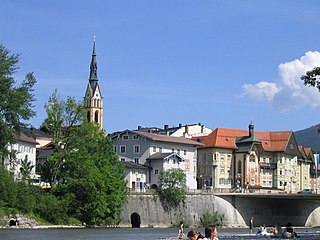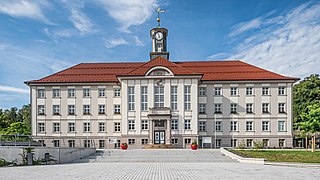Neustadt (Aisch)-Bad Windsheim is a Landkreis (district) in Bavaria, Germany. It is bounded by the districts of Würzburg, Kitzingen, Bamberg, Erlangen-Höchstadt, Fürth and Ansbach, and by the state of Baden-Württemberg.

Karlstadt is a town in the Main-Spessart in the Regierungsbezirk of Lower Franconia (Unterfranken) in Bavaria, Germany. It is the administrative centre of Main-Spessart (Kreisstadt), and has a population of around 15,000.

Günzburg is a town in Bavaria, Germany. It is a Große Kreisstadt and the capital of the Swabian district Günzburg. This district was constituted in 1972 by combining the city of Günzburg – which had not previously been assigned to a Kreis (district) – with the district of Günzburg and the district of Krumbach.

Bad Tölz is a town in Bavaria, Germany and the administrative center of the Bad Tölz-Wolfratshausen district.

Bad Brückenau is a spa town in Bad Kissingen district in northwestern Bavaria in the Rhön Mountains.

Bad Windsheim is a historic town in Bavaria, Germany with a population of more than 12,000. It lies in the district Neustadt an der Aisch-Bad Windsheim, west of Nuremberg. In the Holy Roman Empire, Windsheim held the rank of Imperial City. Since 1810 Windsheim is part of Bavaria. In 1961, it became a spa town and has since been called "Bad Windsheim".

Lindenberg im Allgäu is the second largest town of the district of Lindau in Bavaria, Germany. It is an acknowledged air health resort.

Roth is a town in Bavaria, Germany, the capital of the Roth District. It is located about 25 km south of Nuremberg.

Landau an der Isar is the second-largest town in the Lower Bavarian district, or Landkreis, of Dingolfing-Landau, in the state of Bavaria, Germany. It lies on the river Isar, 120 km downstream from Munich. In 2020, its population was around 14,000.

Hessisch Oldendorf (German pronunciation:[ˈhɛsɪʃˈʔɔldn̩dɔʁf] is a town in the Hamelin-Pyrmont district, in Lower Saxony, Germany. It is situated on the river Weser, approximately 10 km northwest of Hamelin. The adjective "Hessisch" has been used since 1905 to distinguish it from other towns named Oldendorf. Hessisch Oldendorf was part of Landgraviate of Hessen-Kassel from 1640 until 1932.

Marktredwitz is a town in the district of Wunsiedel, in Bavaria, Germany, close to the Czech border, 22 km west of Cheb, 50 km east of Bayreuth and 50 km south of Hof/Saale. Marktredwitz station is at the junction of the Nuremberg–Cheb railway and the Munich–Hof railway. It celebrated the Horticultural Show 2006 in cooperation with Cheb.

Dingolfing is a town in southern Bavaria, Germany. It is the seat of the Landkreis (district) Dingolfing-Landau. Dingolfing is home of a BMW assembly plant.

Haßfurt is a town in Bavaria, Germany, capital of the Haßberge district. It is situated on the river Main, 20 km east of Schweinfurt and 30 km northwest of Bamberg. In 1852, Ludwig's Western Railway reached the town and between 1892 and 1995, which also had a branch line to Hofheim. The 1867 Hassfurt Bridge, thought to be the first Cantilever bridge built, was also there.

Zella-Mehlis is a town in the Schmalkalden-Meiningen district, located in Thuringia, Germany. It is situated in the scenic Thuringian Forest, approximately 5 km north of Suhl and 20 km east of Meiningen. The town was notably home to Walther and Anschütz, two of Germany's most notable firearm manufacturers, both of which were originally founded in Zella-Mehlis. They operated there until Soviet occupation of Eastern Germany at the conclusion of World War II caused both companies to move.

Buttstädt is a municipality in the district of Sömmerda, in Thuringia, Germany. It is situated 16 km northeast of Weimar. The former municipalities Ellersleben, Eßleben-Teutleben, Großbrembach, Guthmannshausen, Hardisleben, Kleinbrembach, Mannstedt, Olbersleben and Rudersdorf were merged into Buttstädt in January 2019.

Tüßling is a market town in the district of Altötting in Bavaria in Germany.

Gestratz is a municipality in the district of Lindau in Bavaria in Germany.

Bad Griesbach im Rottal, or just Bad Griesbach, is a town in the district of Passau in Bavaria in Germany.

Alerheim is a municipality in the district of Donau-Ries in Bavaria in Germany.

Frickenhausen am Main is a municipality in the district of Würzburg in Bavaria, Germany. It lies on the river Main. Frickenhausen is one of the oldest towns of Mainfranken with a beautiful town center.

























